
Tobacco and Medicine Menu: 1 2 3 4 5 6 7 8 9 10 11 12 13 14 15 Next>>
Tobacco and Medicine During the Golden Age of Piracy, Page 8
Tobacco Use and Tools - Cigars
The word cigar was not in use during the golden age of piracy, perhaps because the pipe reigned supreme among English smokers. It almost certainly came from the Spanish word cigarro, which, in turn, came "probably from Maya sicar 'to smoke rolled tobacco leaves,' [which came] from si'c 'tobacco'."1 Another fascinating possibility is presented by the New Zealand Ohinemuri Gazette which explains:
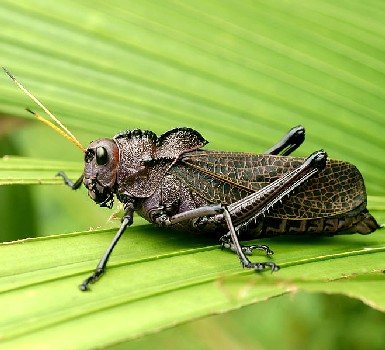
Photo: Hans Hillewaert - Cigar Like?, A Lubber Grasshopper in Costa Rica
When tobacco was first brought from America to Spain, the Spanish dons cultivated it in gardens... it was a mark of class to grow your own tobacco, and when entertaining a friend offer him a smoke 'Es de mi cigarral,' meaning 'It is from my garden.' Foreign misapprehension assumed 'cigarral' to be Spanish for tobacco, the word being used shortened to 'cigarro' to indicate a roll of tobacco for smoking. ...Stranger still is it when the meaning of the word 'cigarral' is examined. 'Cigarral' originally meant 'grasshopper," and because in Spain the grasshoppers were plentiful in the house garden the Spaniards defined the garden as 'cigarral,' or place where the grasshoppers are thickest. So that to-day our word 'cigar' is derived from 'garden;' which was, in turn, derived from 'grasshopper'.2
The online etymology website also notes that the word may have come more directly "from or influenced by Spanish cigarra 'grasshopper, cicada' (on resemblance of shape)", although this seems even less likely than the previous explanation. (Then again, some of the grasshoppers in Costa Rica are as large as a stogie and of a similar coloring.) Whatever its true origin, online etymology dates the first use of word cigar in English to 1730, just after the golden age of piracy.3
Like pipes, the introduction of cigar-like smoking to European history has its roots in
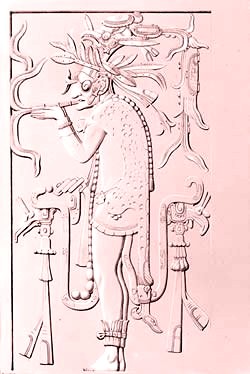
Priest of the Mayas Smoking, Reproduction from
Ancient Mayan Carving, Wellcome Collection
the customs of the West Indies and Central American natives. A variety of different tribes in different places had access to tobacco, which helps account for the reason several different methods were employed to use tobacco. Count Eugenio Courti highlights the depiction of very early cigar smoking seen in Mayan hieroglyphics. He explains that in these images can be "found presentments of priests and soldier engaged in smoking. The pictures resemble those of the Mayas in form and character"4.
Courti elsewhere explains, that tobacco that natives in the Antilles and Central America would "roll palm-leaves into a sort of tube into which they put dried and powdered tobacco, as well as leaves of other aromatic plants"5. Of course, these are not true cigars in that they are not rolled in tobacco leaves; Courti suggests they were instead an embryonic form of the pipe.
Entries in Columbus' journal are a bit vague on what was being used to smoke tobacco, with the interpretation depending on who translated them. In this Tuesday, November 6, 1492 passage, one version says Rodrigo de Jerez and Luis de Torres returned from their exploration of Cuba having "met with many people on the road going home, men and women with a half-burnt weed in their hands: being the herbs they are accustomed to smoke."6 However, Bishop Bartolome de las Casas' version of the Columbus account says that the two men
found on their way many people, men and women, going to and from their villages and always the men with a brand in their hands and certain herbs to take their smoke, which are dry herbs placed in a certain leaf, also dry like the paper muskets which boys make at Easter time [blow pipes]. Having lighted one end of it, they suck at the other end or draw in with the breath that smoke7
Another Columbus-inspired interpretation of a native smoking tobacco rolled in a leaf comes from Matthias de l'Obel & Pierre Pena's Stirpium adversaria nova, seen in the image shown at the bottom of the first page of this article. Antiquarian Frederick William Fairholt explains that this is "an engraving of the tobacco rolled into a tube, as first seen by Columbus in the mouths of the natives... He [l'Obel] 
Artist: Andre Thevet
Methods By Which Natives Make Fire, From Les singularitez de la France Antartique (1558)
(Note: This has nothing to do with l'Obel's image which can be found here.) describes it as a sort of small funnel formed of the palm leaf, in which the dried leaves of the tobacco are placed; fire is applied to it, and the smoke inhaled."8 William Andrew Chatto credits l'Obel with an even broader description:
He thus notices the custom of smoking, which appears at that time to have been fashionable with Captains of West-Indiamen. 'Most captains of ships who have visited that country may be seen carrying a small kind of funnel, formed of a palm leaf or a reed, into the extreme end of which they put the dried leaves of the plant, either rolled up or cut into small pieces; these they apply fire to, and then suck in the smoke, which, they say, allays hunger and thirst, gives them new strength, and exhilarates their spirits: they also assert that it calms the mind with a kind of pleasing intoxication.'9
As interesting as Chatto's interpretation is, l'Obel's actual description is much simpler: "Tobacco [Nicotiana] inserted into a funnel, from which the Indians and ship's captains absorb the fumes."10 Regardless, the tobacco plant can convincingly said to have been rolled inside plant leaves to be smoked before the Europeans discovered the new world.
Unlike the English, who copied pipe use from the natives they encountered, the Spaniards seem to
have adopted cigar smoking based on the method observed by Columbus' men as described. Tobacco was apparently popular enough for the Spanish to begin growing the plant in Santo Domingo in 1531.11 The Spanish liked the product so well that they established other plantations in their 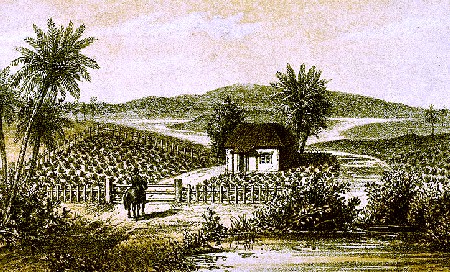
A Cuban Tobacco Plantation, From the Wellcome Collection (mid 19th century)
colonies of Trinidad, Cuba, Mexico and the Philippines around 1535.12
It is rather difficult to accurately attach any early date to the Spanish mass production of cigars. Looking at Cuba, the place often associated with cigar production, some websites say that the Spanish opened the first cigar factory in 154213 without any verification of that claim. At the other end of the spectrum, the American Museum of Natural History states, "Cuba opened its first cigar factories in the early 1800s."14
The first examples of cigar mass production may not be all that relevant to understanding the history of cigars since, as travel writer Henry David Inglis observed, even in 1840 "the Spaniards generally make their cigars at the time they smoke, by wrapping up some tobacco in thin paper, but the inner leaf of the Indian corn is preferred."15 Whatever the case, Spanish protectionism meant that they would rarely have made their way to markets outside of Spain. Archeologist Iain C. Walker explains that "cigars do not appear to have spread beyond Spain to any extent for over two centuries [after their discovery], and when they did, it appears to have been through American sailors, who brought them to Rome where they were being made from 1779."16
The Spaniards were not alone in taking up cigar smoking; Portuguese farmer Gabriel Soares de Souza's 1587 book Noticia do Brazil "informs us that tobacco leaves were much esteemed by the Indian, Negroes (whom he calls Mamelucos), and Portuguese, who 'drank' the smoke by placing together many leaves wrapped in a palm leaf; they used, accordingly, the cigar."17
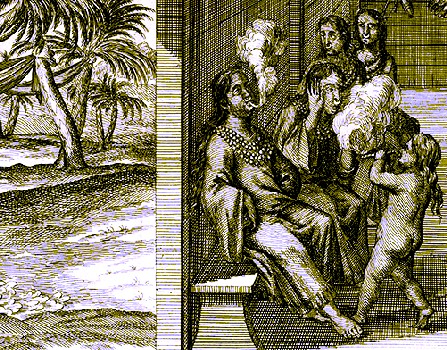
Kuna Natives Smoking in Counsel, From the French Edition of Lionel Wafer's Book (1705)
English buccaneer surgeon Lionel Wafer describes the creation and use of cigars among the Kuna natives during his several month stay with them while recuperating from burning his knee while crossing Panama in 1681. Wafer explains, "When [tobacco] 'tis dried and cured they strip it from the Stalks; and laying two or three Leaves upon one another, they roll up all together side-ways into a long Roll, yet leaving a little hollow. Round this they roll other Leaves one after another, in the same manner but close and hard, till the Roll be as big as ones Wrist, and two or three Feet in length."18 While this sounds like a traditional (if over-large) cigar, their method of smoking it is unusual. Wafer explains,
A Boy lights one end of a Roll and burns it to a Coal, wetting the part next it to keep it from wasting too fast. The End so lighted he puts into his Mouth, and blows the Smoak through the whole length of the Roll into the Face of every one of the Company or Council, tho' there be 2 or 300 of them. Then they... make, with their Hands held hollow together, a kind of Funnel round their Mouths and Noses. Into this they receive the Smoak as 'tis blown upon them, snuffing it up greedily and strongly as long as ever they are able to hold their Breath, and seeming to bless themselves, as it were, with the Refreshment it gives them.19
Wafer's detailed description suggests that he is describing this procedure because it was unusual rather than as a guide on how to smoke for English readers.
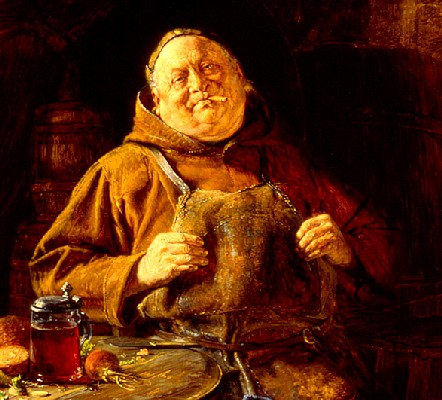
Artist: Eduard von Grützner - A Friar Smoking a Cigar (1897)
The English seem to have primarily restricted themselves to smoking tobacco in pipes during the golden age of piracy. The cigar was still novel enough that when English sailor John Cockburn crossed Panama with a group of other sailors after their ship John and Jane had been captured by the Spanish Guarda Costa in 1730, he feels compelled to explain what a cigar is. Cockburn mentions encountering three friars outside of Granada, Nicaragua who "gave us some Seegars to smoke, which they supposed would be very acceptable. These are Leaves of Tobacco rolled up in such Manner, that they serve both for a Pipe and Tobacco itself."20 Cockburn further notes that the Spanish "know no other Way here, for there is no such Thing as a Tobacco-Pipe throughout New Spain, but [only the] poor aukward Tools used by the Negroes and Indians."21 There would be little reason for him to offer such explanations when his book was printed in 1735 if the English were used to smoking them. (As a side note, this is probably where the 1730 date for the first English use of the word 'cigar' mentioned at the beginning of this section comes from.)
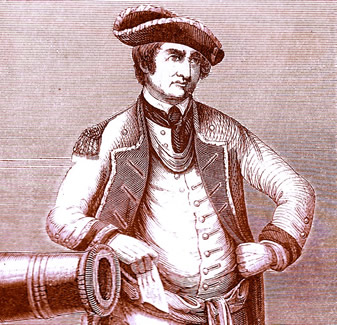
Major Israel Putnam in British Uniform (1758)
Most of the history of cigar use among the English and English Colonies comes after the end of the golden age of piracy. It is suggested that cigars were first brought to the American Colonies in 1762 by American major Israel Putnam, who "returned to Connecticut after serving with the British forces which had captured Cuba, bringing with him three donkey-loads of Havana cigars"22. Whether this is true or not is difficult to verify. Almost as if in support of this, Count Courti states that "about the end of the eighteenth century cigar-smoking began to spread widely in all parts of America."23
Cigars were not to find a firm foothold in England until the very end of the eighteenth century. Fairholt explains that "Heavy duties, and absolute prohibition, helped to keep a knowledge of cigars out of the country."24 He elsewhere notes that the duty on foreign-made cigars "in England was originally as high as eighteen shillings a pound for foreign cigars, [and it wasn't until] after the general Peace of 1815 threw open ports for their admission."25 None of this is to say that sailors could not have encountered cigars, especially given that the Spanish and Portuguese proclivity for them following their discovery of tobacco in the 15th century. Still, they are not mentioned in any of the English sailor accounts under study from the period.
1 "cigar (n.)", Online Etymology Dictionary, www.etymonline.com, gathered 8/28/18; 2 "The Etymology of the Cigar", Ohinemuri Gazette, Vol. XXIX, Issue 3956, 12 August 1918; 3 "cigar (n.)", gathered 8/28/18; 4,5 Count Eugenio Courti, A History of Smoking, Translated by Paul England, 1932, p. 28; 6 Christopher Columbus, Journal of the First Voyage of Columbus, 2003, p. 141; 7 Bishop Bartolome de las Casas, writing in 1527, cited in Footnote 2, Journal of the First Voyage of Columbus, 2003, p. 141; 8 Frederick William Fairholt, Tobacco Its History and Associations, 1862, p. 16-7; 8 William Andrew Chatto/Joseph Fume, A Paper: - Of Tobacco, 1839, p. 18-9; 10 "Nicotiana inserta infundibulo ex quo hauriunt fumu Indi & naucleri", l'Obel & Pena, p. 252; 11 Robert Patrick Wright, The Standard Cyclopedia of Modern Agriculture and Rural Economy, Volume 11, 1908, p. 223; 12 Joseph C. Winter, "Table 1: Early History of Native American and Euro-American Use of Tobacco", Tobacco Use By Native North Americans, 2000, p. 2; 13 See for example: "A Story as Rich as the Scent: The History of Cuban Cigars", Locally Sourced Cuba Tours Website, J. Bennet Alexander, "History of Cuban Cigars", Holt's Clubhouse Webpage & "The History of Cigars in the Old World", finecigars.com.au, all gathered 9/5/18; 14 "Tobacco in Cuba", www.amnh.org, gathered 9/6/18; Henry David Inglis, Rambles in the footsteps of Don Quixote, 1840, p. 68-9; 16 Iain C. Walker, Clay tobacco-pipes, with particular reference to the Bristol industry, vol. 1-2, 1977, p. 56; 17 Berthold Laufer, "The Introduction of Tobacco into Europe", Field Museum of Natural History, Department of Anthropology, Chicago, Leaflet Number 19, 1924, p. 1-2; 18,19 Lionel Wafer, A new voyage and description of the isthmus of America, 1903, p. 109; 20,21 John Cockburn, A Journey Over Land, From the Gulf of Honduras to the Great South-Sea, 1735, p. 139; 22 Walker, p. 56; 23 Courti, p. 206-7; 24 Fairholt, p. 213; 25 Fairholt, p. 219

